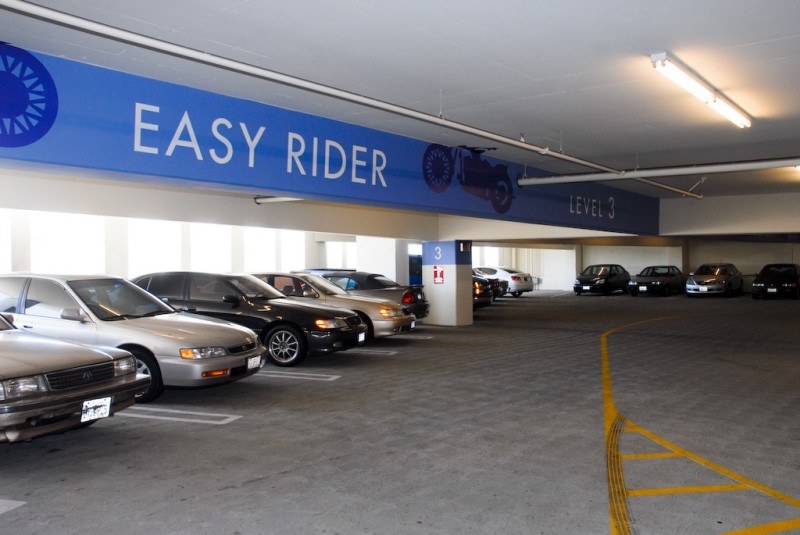Pavement Paradise: American Parking Space

MUCH OF THE MODERN LANDSCAPE is formed by and for the car, and we seem to spend a lot of time and space talking about driving. But driving is at best half the story. In fact, if you think about it, driving is just a brief interstitial act of motion between protracted periods of parking. Despite how much we value them, and despite how much we spend on them, most cars are parked for more than 90% of their lives.
Parking is something all drivers want to have, ultimately, but to think about as little as possible. However, this liminal and static space of automotive transience—parking—has a great impact on our lives and surroundings.
Pavement Paradise: American Parking Space, shown at CLUI Los Angeles in the fall of 2007, and made possible by a grant from the Los Angeles Department of Cultural Affairs, examined parking space, from the micro to the macro, drawing examples from Los Angeles’ parking-scape.
A full size parking space from a nearby shopping plaza (from outside the Baja Fresh/Panda Express building at Culver Center on Venice Boulevard) was recreated on the floor of the CLUI exhibit space, using adhesive parking lot tape, signage, and a wheelstop. Transplanting a parking space from outside to indoors shifts the scale of both the parking space, and the room, and the transposed parking space, a substanceless, quotidian artifact, gains new stature and relevance when brought inside. Around it, canted plaques in the room labeled and explained different elements of the space, such as the role of the concrete wheelstop:
The wheel stop is the often overlooked workhorse of the parking space. It is usually 6 inches high and 4 or 6 feet long, and is used to stop a car at the forward end of a space. Typically made of concrete, new plastic models are increasingly popular. Its use is contested, as it is often the only vertical obstacle in a parking lot, and it constitutes a major tripping hazard for pedestrians. Wheel stops also make cleaning lots more difficult. However, they are very useful in preventing cars from hitting nearby light poles or walls. They are also used in larger lots with traffic islands, where they prevent people from parking too far forward in facing stalls, and, more importantly, discourage people from driving across vacant stall areas, which is considered a hazardous parking lot activity. A larger source of accidents in lots however is caused by cars backing out of spaces, something that the use of wheel stops requires.

Other physical features of the exhibit, such as parking signs and striping, explored the origins of the dimensions of a typical parking space, the standards for disabled parking, and the history of the parking meter:
Parking meters were first used in Oklahoma City, in 1935, as a parking control device to help enforce short term parking regulations at high density curbsides. In Los Angeles, 88% of the meters have a 1-2 hour limit. A staff of 30 maintain the city’s 40,000 meters, which generate $20 million a year. However, much more revenue is made from parking tickets issued for expired meters. In many cities, the mechanical timing mechanism is being upgraded to an electronic system. The housing is generally reused. New York City replaced its last mechanical meter in 2006. Duncan Parking Technologies, based in Arkansas, is one of the largest manufacturers of parking meters. They began making parking meters in 1936, as a sideline of the Duncan Toy Company, which manufactured the Duncan Yo Yo. The first parking ticket for an expired meter was issued in Oklahoma City to a local minister who complained to the judge that he was getting change to put in the meter from nearby store and returned to find the ticket on his windshield. The judge accepted his argument, and the ticket was excused. This legal precedent, however, has not remained effective.
Beyond the physical elements in the exhibit space (parking’s “material artifacts”), the exhibit consisted mostly of images and text projected on two screens on the wall. One screen focussed on the development of parking spaces, on-street parking management techniques and infrastructures, parking space code requirements, and domestic parking, including the effect of parking on residential architecture. The second screen addressed parking lots and parking garages: their creation, evolution, forms, management, ownership and the like.

The exhibit also included a looping video of the view of a nearby parking lot at a typical shopping plaza, shot from the roof of the Best Buy at Culver Center, down the road. This wide angled view enabled people to see the complex orchestrations of individual car behavior in a dense and active commercial parking space. The movement of cars is an expression of the desires, motivations, and sentiments of their drivers, forced to contend with the complications of continuous arrival and departure.
A video about parking by Ryan Griffis of the Temporary Travel Office, called Parking Public: A Brief Tour Into the Storage of Utopia, helped to illustrate some of the larger societal issues about parking. A publication, Pavement Paradise: American Parking Space, was produced by the CLUI, in conjunction with the exhibit.
Since parking is generally perceived as non-space, the exhibit was purposely ephemeral and transient in its constituents. Perhaps this notion was detected by David Pagel, an art reviewer in the Los Angeles Times, who said, “Although there is not a single work of art on display, ‘Pavement Paradise’ does art’s job efficiently and with significantly less to-do than usual.”
One material artifact from the exhibit has stayed in the CLUI space as a semi-permanent fixture. The Duncan parking meter, anchored to the floor, remains by the reception area as a reminder for visitors to feed the meter! ♦